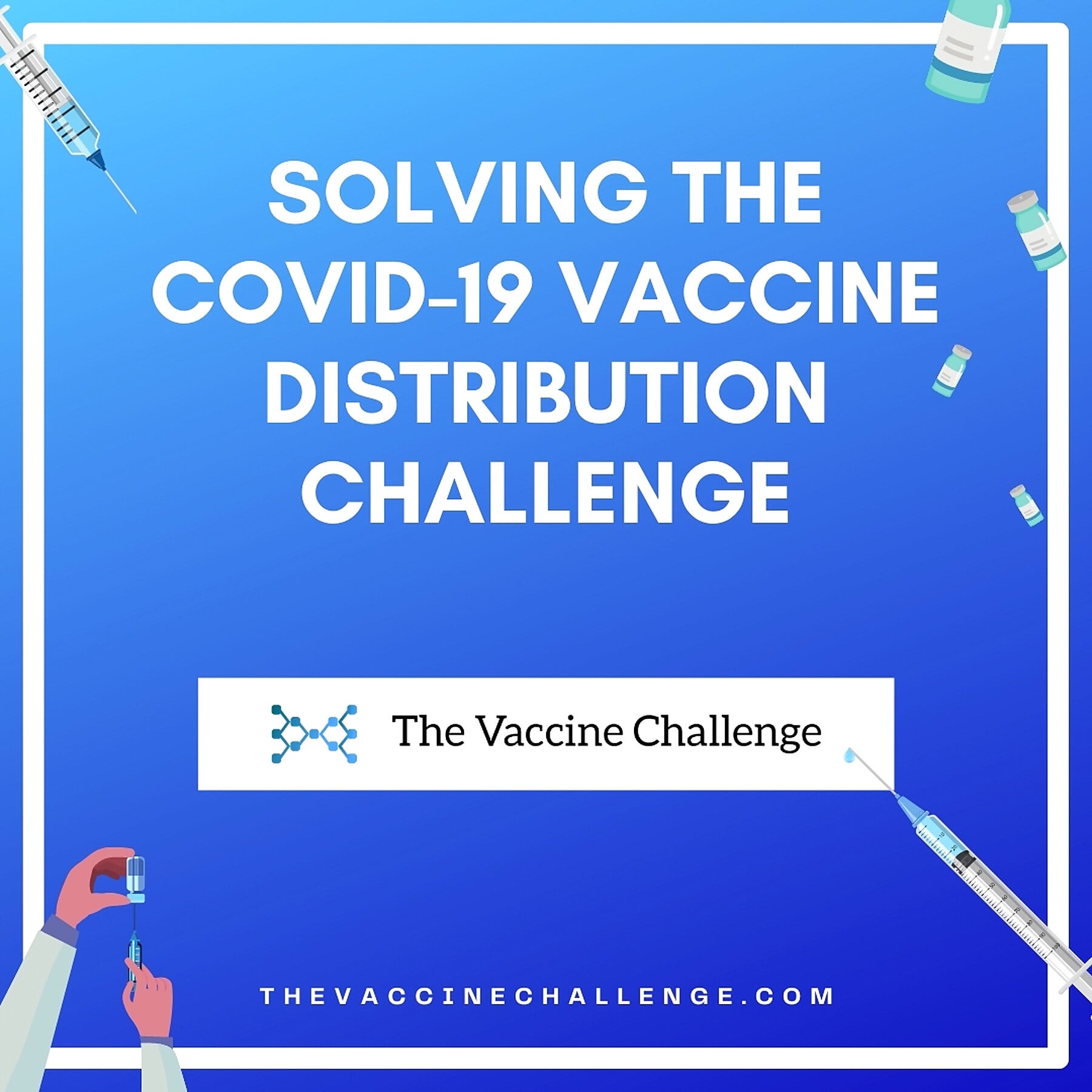Episodes
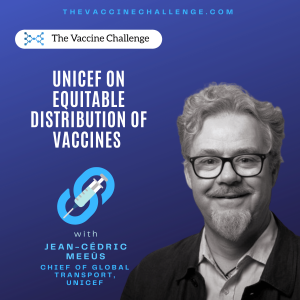
Wednesday Jan 05, 2022
UNICEF on equitable distribution of vaccines
Wednesday Jan 05, 2022
Wednesday Jan 05, 2022
This episode of The Vaccine Challenge is hosted by Priyanka Asera and features Jean-Cedric Meeus, the Chief of Global Transport at UNICEF. UNICEF plays a KEY role in ensuring that low income countries get access to vaccines and medicines. This is something they’ve been doing for decades and are one of the biggest buyers of vaccines globally. Today, we will be talking about various things include what challenges COVID posed when the lockdowns first kicked off, what are the challenges in purchasing and procuring vaccines given that they’re having to compete directly with governments around the world that are procuring vaccines from manufacturers directly, distribution challenges when it comes to getting the vaccines in low income countries, as well UNICEF’s relationship with WHO and GAVI.
SUMMARY OF THE PODCAST INTERVIEW:
Could you describe the scope of work that UNICEF does and its relationship with WHO and GAVI?
- UNICEF was founded in 1946 after WW2 in order to care for the children. UNICEF has bought over 1.4 billion doses of COVID vaccines. But does 2 billion doses of other routine immunization vaccines globally.
- UNICEF is essentially the procurement and delivery partner. WHO is the regulatory framework, and will certify every vendor for specific supplies and specific packaging
- We also work with the different governments’ Ministers of Health, to make sure they have the proper equipment which we help procure, ship and install. We essentially work on immunization and consultative activities, to support low income countries to make sure that they have derived commodity at quality and price for caring about the population and mostly the children
What were some challenges that UNICEF faced in 2020 directly as a result of the lockdowns?
- Used to have 14000 shipments on commercial airlines on a daily basis, and this was essential commodity that could not be interrupted - such as medication used to support malnutrition, fight malaria etc. But when the lockdowns happened, commercial airlines stopped flying and countries blocked airspace. Had to choose other means - such as sea trade, increased partnerships with airlines to prioritize COVID shipments.
- One of the biggest problems in the early days was obtaining protective equipment from Asia.
- But we had 5 year agreements with global freight forwarders that enable massive flexibilty in our supply chain so it wasn’t very bad from the lockdowns itself
What are some general supply chain and distribution challenges when it comes to vaccines in even a non-pandemic world?
- Forecast. We do a growth forecast every 5 years for five years ahead so we can inform the industry how much of specific vaccines are needed in order to make sure we’ve accounted to every country the right amount needed
- Shipments. Usually happens on commercial airlines and have cold chain requirements but this is pretty routine.
- Supporting material such as syringes and devices needed for immunization can be very voluminous and are often shipped via sea, whereas vaccines are shipped via air. So knowing having the right forecast of when all the material is needed by the governments for the immunization efforts is important because everything has to arrive at the same point of entry in a timely manner
Let’s talk about what the commitment has been for COVID vaccines and the challenges:
- The GAVI and COVAX alliance has committed to more than 2 billion vaccines procurement for the 52 low income countries.
- In general, introducing a new vaccine to a country takes 10 years because need to look at specifications, capacity, temperature requirements, regulatory framework etc. But for COVID, we had to prioritize and get it out in under a year which is unprecedented.
- We are competing with other governments that are procuring the vaccines from the same limited suppliers. So while we’ve committed to purchasing 2 billion, we were at 111 million at 5 months. We’d have even liked to procure more if more vaccines were available so that’s a major challenge.
- Another huge challenge is the ethical distribution of vaccines. Nobody is safe until everybody is safe and vaccinated. So we try to ship to as many countries as possible. The aim was to cover 20% of the population so as soon as quantities are available with different suppliers we work on on understanding how many dozes different countries have received and are able to receive and use.
- Sometimes, for example, 5% of the population of Nigeria is easy to manage because it is large volumes. But 5% for a small island country that might need 20 or 50 kilos, that’s a challenge. Sending 50 kilos can be more complex than sending 500 tonnes.
What are the factors that go into deciding which countries or regions get prioritized and why? (In addition to externally changing factors that might need to be considered in addition to regular equitable distribution).
- Readiness capacity, capacity of storage and distribution, readiness to absorb and organize administrative campaigns as soon as possible because a lot of the vaccines have short shelf lives
- Situation in the various countries with respect to how the pandemic is shaping up and who is at bigger risk of spread
- Multiple factors go into deciding through a formula how it will be distributed and allotted. The WHO makes these decisions thought. UNICEF’s role is to execute.
About Jean-Cédric:
Jean-Cedric Meeus work focusses on improving supply chains with UNICEF since 2001. He is currently the Chief of Global Transport at UNICEF Supply Division covering off shore and in land transport. Since 2001, Jean-Cedric performed in different Supply chain functions based in Mozambique, HQ NY (Supply Emergency Response Officer), HQ Copenhagen (Chief Emergency Supply Manager), Dakar Regional office of Western and Central Africa as regional (RO Supply Chain manager) to finally take his current position in Copenhagen.Prior to UNICEF, Jean-Cedric performed as Supply and Program Technical Specialist with MSF for 9 years in different countries.
Jean-Cedric has led and managed emergency operations and Supply chain teams in a wide range of global humanitarian crises and development programs over the past three decades. Constantly seeking new challenges, and through humanitarian and private sector networks, he strives to improve delivery of humanitarian aid by influencing and implementing practical, innovative changes. Through Jean-Cedric’s different positions he managed pharmaceuticals, immunization, health, education and WASH commodities to be delivered from origin to beneficiaries in support to UNICEF and government program activities.
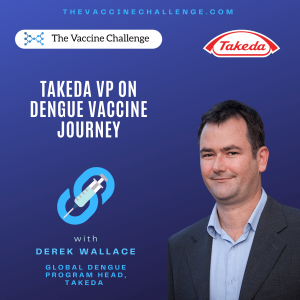
Thursday Sep 16, 2021
Takeda VP on Dengue Vaccine Journey
Thursday Sep 16, 2021
Thursday Sep 16, 2021
This episode of The Vaccine Challenge is hosted by Priyanka Asera and features Derek Wallace. Derek is the VP and Global Dengue Program head at Takeda. Derek has been at Takeda since 2013, but has over 16 years of experience in clinical development, infectious diseases and medical affairs from working at Merck, Novartis and Sanofi Pasteur. Takeda is on the cusp of having a vaccine for dengue approved - and today we talk about how dengue affects the world, which regions get most hit, what the impact of the vaccine will be in alleviating the threat it presents, what happens behind the scenes to get the vaccine approved, and how does a company plan for execution when there is no clear date estimation of when the approvals are likely to come in. We also talk about whether or not the speed in covid vaccine approvals will have a long lasting impact on all vaccine approvals going forward. For this and more… listen on.
SUMMARY OF THE PODCAST INTERVIEW
Could you share some context on the impacts of dengue world over?
- In 2019, the World Health Organization named dengue, one of its top 10 threats to public health.
- Affects tropical and sub tropical countries across the globe, particularly in Asia & Africa.
- The disease is caused by a virus spread by mosquitoes so it’s a vector borne viral disease.
Describe the pathway to development of this vaccine, that’s now almost on the cusp of approval.
- Takeda have been developing the vaccine since 2013 but its history is much longer than that. Our vaccine is for a serotype that was originally identified back in the 1980s in Thailand and was attenuated by the CDC in USA.
- Some of the early phase work was done by a company called Invitrogen, Takeda took over at the beginning of Phase 2.
- It was a very large scale trial - enrolled 20,000 children aged between 4 and 16, across 8 different dengue endemic countries across Asia and Latin America. The study was 4.5 years long. Then, after 3 years of follow up, we felt in a position to provide the data to regulatory authorities. So we’re currently under review.
Can you explain the approval process in different countries?
- Submitted our file to the European authorities in March 2021. Shortly afterwards, it was submitted to a number of dengue endemic countries.
- European authorities assist in the review of a product that is also under parallel review by the individual countries. So for example, we have Colombia, Argentina, and Brazil, in Latin America that are participating in this process, each of those countries get exactly the same file that Europe gets. And the reviews occur in parallel where the the comments and the questions that come from regulators are shared between the regulators.
- Each individual country will clearly make its own choice, but it strengthens the quality of review. So we're in that process now. And we would expect the CH MP opinion before the end of our fiscal year together, which is before March of 2022.
What happens once the vaccine is approved? Talk to me about the logistics.
- Particularly complicated because we're going to so many countries in parallel. We've prioritised early registrations in places where the vaccine is needed the most. Eg. Argentina, Colombia, Brazil, Philippines, Indonesia, Malaysia, and will be submitting into Thailand, Sri Lanka, Mexico and the US in the coming months.
- We'll also be considered for public programs, which is really what recommending bodies do. Need a plan that's specific to each country, provide as much information as we can on the on the risks and benefits of the vaccine, understand the epidemiology in those particular settings. And essentially, the right recommending bodies will decide how the vaccine should be used for that particular context.
How do you make contingency plans not knowing when exactly the vaccine will get approved?
- We have to make assumptions about how long the regulatory process will take. And so we can have a base case for when we would expect to to launch a vaccine following approval. But of course, that can be faster than we expect or slower than we expect.
- Where it's faster than we expect, the rationale is clearly that there is maybe an ongoing epidemic in that country and a very clear need for an acceleration of review, so then we have a real obligation to make sure the vaccine is is available in an accelerated way.
- This means our supply chain has to be robust, we have to have a lot of scenario planning. We do get a little bit of time, because there are some activities that have to occur prior to launch after approval. There are processes we need for importation for example, that need to occur following approval. And these typically take a couple of months.
- But if we waited to manufacture after approval, we wouldn't be able to supply the kind of demand that we would expect. So we have to make a lot of investments that are essentially at risk. We have been making commercial material for some time now at our contract manufacturer in Germany, essentially building inventory so that we're able to manage sudden spike in demand.
ABOUT DEREK
Derek Wallace, MBBS, is Vice President and Global Dengue Program Head at Takeda. In this role, Mr. Wallace leads the global program team in the development of Takeda’s dengue vaccine candidate (TAK-003). Mr. Wallace joined Takeda in September 2013 as Global Programme Medical Director responsible for the development of TAK-003 as well as Takeda’s enterovirus vaccine candidate.
Mr. Wallace has over 16 years of experience in clinical development, infectious diseases and medical affairs. Prior to joining Takeda, Mr. Wallace held clinical development and medical affairs positions at Merck, Novartis and Sanofi Pasteur. At Sanofi, Mr. Wallace served as clinical team leader for Sanofi’s dengue vaccine candidate, influenza studies and preparations for first-in-human studies of vaccine candidates for malaria and meningitis B. His experience also includes transplant, cardiology and women’s health.
Mr. Wallace holds a Diploma of Vaccinology from the Institut Pasteur and a Diploma in Pharmaceutical Medicine from University of Wales, Cardiff. He received his Bachelor of Medicine, Bachelor of Surgery from the University of Queensland.
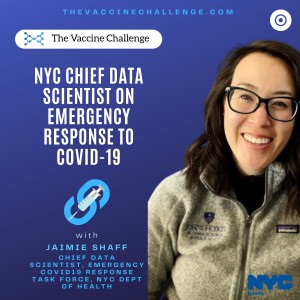
Thursday Sep 02, 2021
NYC Chief Data Scientist on Emergency Response to COVID-19
Thursday Sep 02, 2021
Thursday Sep 02, 2021
This episode of The Vaccine Challenge is hosted by Priyanka Asera and features Jaimie Shaffs. Jamie Shaffs is the Chief Data Scientist of the New York department of Health and Mental Hygiene as well as a member of the COVID-19 Emergency Response Task Force. Jaimie has assisted various emergency responses in India, Africa prior to this for health and refugee crisis. Jaimie is an epidemiologist and is pursuing a PhD in Health Equity and Social Justice at Johns Hopkins.
In this podcast Jaimie answers how her department reacted to all of the challenges as they were developing, the role that data had to play in orchestrating the response and how did the department address all other issues arising from the pandemic within the communities in New York. She also answers how emergency departments across the world share knowledge amongst each other so that we are better prepared collectively next time around.
SUMMARY OF THE PODCAST INTERVIEW
Could you describe the scope of work you do?
- We lead the health response for the emergency in New York City in particular an emergency response group called the Integrated Data Team
- Our role is to ensure the agency and response leadership have access to accurate and timely information to make decisions
- Generally, our work is to mitigate the impacts of COVID-19 in New York City
What kind of data do you rely on to make the right real-time decisions especially when New York was facing its second wave last year?
- Data in this response has been one of the most interesting evolutions. We started with very little data available and were trying to find anything that we could to inform the response.
- At this stage there is access to incredibly rich data across all over the world which helps in a great way.
- The public health laboratories and the epidemiology department have done a tremendous job by bringing in data on COVID-19.
- It includes data on testing, hospitalisations and deaths. It also included confirmed cases, probable cases which were very important data that helped in the process.
What kinds of number and models do you track outside of New York and outside the United States and how does that happen?
- The process has eventually evolved with time. Initially we had very little data coming from scientific colleagues in China and South Korea and as the outbreaks made their way to Europe we started getting data about the impacts in Italy, Spain, etc.
- The most important data point at the very beginning was about the case fatality rate. In the winter of 2019 and the beginning of 2020 COVID was seen as a bad flu and later did we realize its severity looking at the fatality rate from all over the world.
- Now, we are tracking the variants in different countries, their impacts and the way that they are behaving and also on the efficacy of the different vaccines.
What do you think happens to data ownership when it comes to a situation like this?
- Our unit does not focus on the academic part and we really try to get as much as data put there as possible that it helps everyone while also ensuring that it is as correct as it can be.
- Other colleagues maybe more focused on academic publications. Making sure that folks are included in publications is as important as sharing data. We have seen some really great academic and non-academic partnerships.
- Generally, it is an emergency and at some level we have to inform to the public that we have the data that we need to inform the response at the same time we have to protect patient privacy which is a really critical piece that we do.
Were there any policy decisions that were to be made by the task force?
- So many decisions were to be made by the task force. In the beginning, conversations about closing schools, implementing state home orders, about mandating testing in different venues for different populations of people.
- As we started to reopen we had to think about capacity limits for indoor settings, face covering requirements, etc.
- Now it is a lot related to vaccination like who is eligible to get vaccinated, how the vaccine will be distributed, what population which receive the vaccine first, etc. There are a number of policy decisions that are complicated and complex. Yet it has been a very interesting and evolving conversation from a policy perspective.
What are the top reasons why you people may not have gotten vaccinated yet?
- As public health professionals we have to make sure that the people have all the information that they need. In general there is so much misinformation out there.
- It is difficult to be confident in a vaccine that is relatively new and it literally our job to make sure we are getting the right information to the people and help them make an informed decision about their vaccine choices.
- People think about missing work due to the side effects or the after effects of the vaccine and not everyone get a paid sick leave which is a very basic issue.
- We have to make sure that the people know all information like the available providers, times at which vaccines are provided, the side effects of the vaccine and why they should get vaccinated.
ABOUT JAIMIE
Jaimie Shaffs is the Chief Data Scientist of the New York city department of Health and Mental Hygiene as well as a member of the COVID-19 Emergency Response Task Force. She had come to the domestic public health sector after serving a humanitarian c areer where her work was with international NGOs working on humanitarian emergencies ranging from malnutrition to infectious diseases outbreaks to refugee crises and food emergencies. All of her experiences with the humanitarian sector helped develop the skills and mindset to work in the public health sector. Jaimie has assisted various emergency responses in India, Africa prior to this for health and refugee crisis. Jamie is an epidemiologist and is pursuing a PhD in Health Equity and Social Justice at Johns Hopkins.
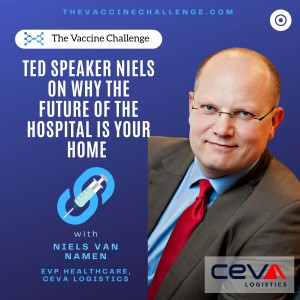
Friday May 21, 2021
TED speaker Niels on Why the Future of the Hospital is your Home
Friday May 21, 2021
Friday May 21, 2021
This episode of The Vaccine Challenge is hosted by Priyanka Asera and features Niels van Namen.
Niels van Namen is an experienced Healthcare supply chain professional, entrepreneur and TED speaker. Niels is passionate about Patient Centric supply chains, improving patient outcomes and making Healthcare affordable and accessible for everyone.
Niels currently leads the global CEVA Healthcare team as the Executive Vice President for the Healthcare Sector.
With the pandemic fueling telehealth and other home care, I sat with Niels to chat about how the future of healthcare that he had envisioned in 2018 is becoming ever closer to reality.
Questions answered are around who the key players that emerge in this new world will be, how will interaction with the patient change, how will insurance be redesigned, and the role that logistics will play in order to make this a reality.
Niels’ 2018 TED talk details his vision of the future of care delivery and the importance of Logistics: https://www.ted.com/talks/niels_van_namen_why_the_hospital_of_the_future_will_be_your_own_home?language=en
Questions answered include:
- In 2018 you did a TED talk on why the hospitals of the future will be in our homes. Can you give us a 60 second summary of what the premise is.
- What are the key drivers to making this future possible? Why now?
- If this is the future, how do you think this will impact the health insurance industry? Both in countries where there’s public healthcare vs the US where it’s predominantly privatized?
- COVID has massively changed how we engage with doctors and general consumer behaviour towards technology. Can you quantify what kind of tail winds COVID might have added to this envisioned future of healthcare?
- Who are going to be the big players that emerge in order to make home healthcare a reality? Healthcare providers, tech companies, other new players?
- How will this impact cost and spending? Who will be the winners and losers, strictly from a financial perspective?
- How will data ownership shift or change?
- If we move towards home healthcare predominantly, and if this means that the capacity in hospitals is significantly lesser than today … would this make us moreor less prepared for the next pandemic, if there is one?
About Niels:
Niels van Namen is an experienced Healthcare supply chain professional, entrepreneur and TED speaker. Niels is passionate about Patient Centric supply chains, improving patient outcomes and making Healthcare affordable and accessible for everyone.
Niels currently leads the global CEVA Healthcare team as the Executive Vice President for the Healthcare Sector.
Niels has over 25 years of experience in the healthcare and life science industry of working closely together with customers across R&D, supply chain and manufacturing. He is passionately involved in key developments and supply chain challenges.
Niels started his career as an engineer and an entrepreneur in clinical trials management. Niels initiated Diagnostic Units, a company performing clinical trials and providing regular diagnostics and care to patients in Europe. Niels joined the PWC/IBM Healthcare consulting practice. He joined DSV to lead the Healthcare vertical. Niels then joined UPS to lead the Healthcare sector for Europe.
Niels is a PDA member, holds an MSc from Delft University of Technology, obtained his MBA on the Rotterdam School of Management and holds a certificate from l'École Nationale des Ponts et Chaussées in Paris. He lives in the Netherlands, is married and has three children.
Niels’ recent TED talk details his vision of the future of care delivery and the importance of Logistics: https://www.ted.com/talks/niels_van_namen_why_the_hospital_of_the_future_will_be_your_own_home?language=en
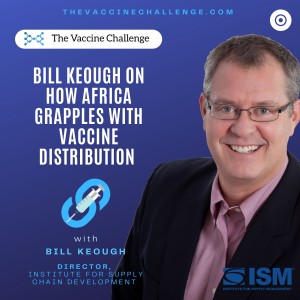
Thursday May 13, 2021
Bill Keough on how Africa grapples with vaccine distribution
Thursday May 13, 2021
Thursday May 13, 2021
This episode of The Vaccine Challenge is hosted by Priyanka Asera and features Bill Keough.
Bill Keough is the Director of the Institute for Supply Chain Development (ISCD), which provides leading-edge supply chain training for health professionals working in low-resource environments. ISCD combines online technologies and platforms with a unique pedagogical approach specifically designed to deliver quantifiable student learning outcomes. ISCD has completed projects for clients including UNICEF, VillageReach, USAID, the Africa Resource Centre, People that Deliver, GAVI, and others.
We asked Bill about the challenges in vaccine distribution in African countries where there is lower resources and a relatively less developed infrastructure
Questions answered include:
- Vaccine distribution challenges are very different in countries with a lot of resources and solid infrastructure. What are some basic challenges in countries that don’t have enough resources and an infrastructure to support vaccine drives?
- You’ve done a bunch of work with some African countries in their distribution efforts. Can you share some constraints and challenges they have to work with?
- How is their supply chain set up for vaccine distribution?
- Can you share a few interesting or creative initiatives that are happening in Africa?
- Do interesting/unique ideas get shared and used in other countries with similar challenges? How can we make sure cross-border knowledge transfer happens?
- Do you think anything will change in the world of vaccine distribution in low-income countries in the future as a result of this global pandemic?
About Bill
Bill Keough is the Director of the Institute for Supply Chain Development (ISCD), which provides leading-edge supply chain training for health professionals working in low-resource environments. ISCD combines online technologies and platforms with a unique pedagogical approach specifically designed to deliver quantifiable student learning outcomes. ISCD has completed projects for clients including UNICEF, VillageReach, USAID, the Africa Resource Centre, People that Deliver, GAVI, and others.
In 2010 Bill created the online Supply Chain Transportation and Logistics Master’s program at the University of Washington. Bill is currently a professor in the Department of Civil and Environmental Engineering (where the program is housed) and he serves as the program’s Managing Director. The program has consistently been ranked as one of the top 5 programs in the United States.
In addition to his role at the University of Washington, Bill’s teaching background includes work with Rice University, the University of Houston and the Global Supply Chain MBA program at the SP Jain Centre of Management, with campuses in Singapore and Dubai. He has taught executive education courses in Benchmarking & Performance Management for the Council of Supply Chain Management Professionals (CSCMP) and the Warehouse Education and Research Council (WERC). Bill publishes regularly in journals like the Supply Chain Management Review and speaks at supply chain industry conferences.
Bill’s private sector experience consist of more than 20 years as a management consultant in operations, enterprise technology, and supply chain management. Bill has held senior positions at IBM, Computer Sciences Corporation (CSC) and Schlumberger; he currently also manages his own supply chain consulting firm, Keough Associates, which helps organizations improve the performance and cost-effectiveness of their supply chains.
Bill holds an undergraduate degree from Cornell University and a Master’s degree from the University of Houston. He speaks fluent French and Spanish.
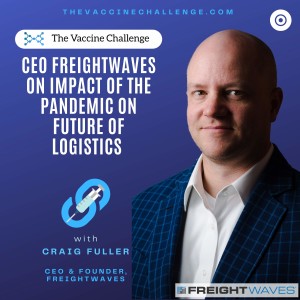
Thursday May 06, 2021
Thursday May 06, 2021
This episode of The Vaccine Challenge is hosted by Priyanka Asera and features Craig Fuller, Founder & CEO, FreightWaves.
FreightWaves is the leading publication in freight and brings data and analytics to the global $9.6tn industry. Where there was so much speculation about how difficult the logistics was going to be for vaccine distribution, we asked Craig to validate if that was true and what are the actual bottlenecks in distribution from his perspective.
We also asked Craig to give us a lowdown of how things played out in the freight market when lockdowns first started happening in March 2020 and what is set to change permanently in the world of freight and logistics as a result of the pandemic.
Summary of the podcast interview:
Can you define what comprises of the cold chain and was there a lack of supply chain capacity to move the vaccines like a lot of media speculated in the early days?
- Cold chain – in trucking it’s reefers, in sea shipping it’s refrigerated containers, in warehousing it’s freezing units. It’s just the need to maintain integrity of temperature range
- A lot of mainstream media talked about lack of supply chain capacity to move vaccines. That was actually never an issue. The actual issue was actually just at the final inch – like how the states were distributing the vaccines to the health professionals. The cold chain had plenty of capacity and could easily flex up with the use of dry ice
- At peak capacity, it was only 30 reefers a day moving out of vaccine manufacturers that was required. The vaccines just don’t take up that much space. This is less than 0.1% of all reefers in the US market
- Media blew it way out of proportion. For context – Walmart will see way more traffic in 1 facility in a day than was required for the vaccines
What have been the actual challenges and bottlenecks in vaccine distribution been?
- Bottleneck in vaccine distribution was how poorly the coordination was done between the states. They just followed the emergency response model where federal government acts as an insurance provider, and then leaves it to states to manage the execution
- No problem getting vaccines to rural America either. Problem is people there don’t want the vaccine. In the cities, it was difficult to get appointments initially because there wasn’t enough supply but if you drove 20 mins out to the rural communities, it was immediately available
- Failure on part of federal and state government planning because they distributed the vaccine based on population distribution not taking into account the demand patterns of the demographics
What was the implication on supply chain and logistics as a result of the pandemic? Which companies emerged stronger as a result?
- Pandemic – huge tailwind for the industry. Throws a light on need for sophisticated supply chains. Shows stark difference between high volume, efficient, data-centric supply chains –found in retail and CPG that move massive numbers of SKUs. And then you see less robust/less sophisticated SCs in other industries
- Panera Bread and Chipotle did a great job pivoting and upgrading their SCs. Earlier handled a relatively small business on-demand but have migrated to mostly all on-demand
- Target had a couple of substantial quarters because they were ready for curb-side pick-up and deliveries well before the pandemic
- Food delivery has forever changed. Packaging has changed forever – restaurants are making sure their packages are more robust
- Visibility, track & trace, and having chain of custody information is going to be table stakes for companies going forward
What data surprised you in the last year as the pandemic was playing out?
- In late Feb, we realized US was going to be impacted by COVID because of shut down of China and what that would mean for domestic transportation flows
- Early March to March 22-23 there was massive demands for products
- In April we made a controversial call and predicted that the freight market was going to have an aggressive V shaped recovery. Even internally, there was a big disagreement. But that’s what the data suggested. We were right, the markets bounced back so strong because they were as low as they would be at that point
About Craig
Craig Fuller is the CEO and founder of FreightWaves, the leading provider of data and analytics for the global logistics industry. FreightWaves provides the fastest view of transportation and logistics market activity, across all modes. The company is also the No.1 source for media and market analytics in the global freight industry.
Prior to founding FreightWaves, he was the founder and CEO of TransCard, a fleet payment processor that was sold to US Bank. He also has been deep in the freight industry, having founded and managed the largest provider of on-demand trucking services in North America, the Xpress Direct division of US Xpress Enterprises.
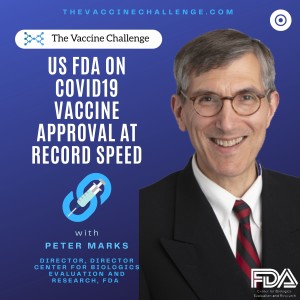
Friday Apr 30, 2021
US FDA on COVID19 vaccine approval at record speed
Friday Apr 30, 2021
Friday Apr 30, 2021
This episode of The Vaccine Challenge is hosted by Priyanka Asera and features Peter Marks, Director, Director Center for Biologics Evaluation and Research, Food & Drugs Administration.
We’ve asked Peter some really important questions around how FDA has been giving vaccine approval at record speed, why the embargo on vaccine raw materials to rest of the world, their relationship with other regulatory bodies, and whether there will be permanent changes in how the FDA functions, development and approval timelines given the speed at which these vaccines have come to market.
If you want to hear more from Peter, he is a speaker this year at the Disease Prevention & Control Summit, a two-day virtual event taking place on July 20-21st, focusing on some of the most important topics across the COVID-19 space, including vaccines, therapeutics, diagnostics, and health equity. Priyanka will also be moderating a panel on vaccine distribution, so make sure not to miss it! Link to register for free is below. Link to free registration: https://bit.ly/2Qzvjpy
Summary of the podcast interview:
How do you think the rollout has been going on under the two different administrations?
- Three vaccines have been authorised for emergency use.
- Despite speedbumps, the rollout has gone as well as expected
How does FDA collaborate with regulatory bodies of other countries?
- FDA is a global lead in the area and has been working closely with WHO.
- If the entire world doesn't get inoculated, we would not be in a position to suppress COVID
Has the collaboration between different regulatory authorities been deeper due to COVID?
- FDA has been working in close collaboration with agencies like CDC in the US
- They have a weekly meeting with CDC, and a deep personal relationship between the two agencies has developed.
- Around the world, regulators have come closer to handle the emergency
What is FDA's role in the Vaccine process?
- To ensure safety around the vaccine, however they do not have a say on how the vaccine is used
- Currently, FDA is closely monitoring the adverse events around the vaccine and what the risks are
- FDA has made the vaccines available under emergency use authorization, this is different from regular use
- Despite the streamlined approval process, care has been maintained to ensure the same safety information is available to the public
- 8 months is the regular approval process, this was possible because they were working with the Pharma companies when they were developing the vaccine
With the new COVID variants coming in, does the vaccine strategy change?
- FDA has developed a playbook to quickly tackle strain changes
- The current batch of vaccines should take us through the current wave
- This might look similar to influenza
With the vaccine rollout in full swing, how does the FDA keep track of possible adverse effects of the Vaccine?
- FDA has collaborated with CDC and has an overlapping set of safety surveillance
- FDA has developed an active system through Medicare and Medicaid system which helps them keep track of 100 million lives
- Currently, fifteen different adverse events are being monitored
Follow up to that: The J&J vaccine is being re-examined, can you shed some light on the process of how it could be reintroduced to the public
- Once the relevant information was gathered, CDC and FDA came together to re-approve the vaccine
- Providers were sensitized to treat the adverse effects should something crop up
About Peter
Peter Marks is an American hematologist oncologist serving as the Director of the Center for Biologics Evaluation and Research within the Food and Drug Administration. He was appointed to the position in 2016 after previously serving as deputy director.
In May 2020, he was selected to serve as a member of the White House Coronavirus Task Force, although he left a few days later over concerns that his participation would represent a conflict with his position at FDA. Marks also played a role in establishing Operation Warp Speed, a partnership between the federal government and various private companies to develop a COVID-19 vaccine.
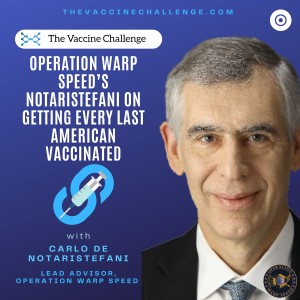
Wednesday Apr 21, 2021
Operation Warp Speed’s Notaristefani on Getting Every Last American Vaccinated
Wednesday Apr 21, 2021
Wednesday Apr 21, 2021
This episode of The Vaccine Challenge is hosted by Priyanka Asera and features Carlo de Notaristefani, Lead Advisor Manufacturing & Supply Chain at Operation Warp Speed.
Operation Warp Speed is a public–private partnership initiated by the US government to facilitate and accelerate the development, manufacturing, and distribution of COVID-19 vaccines.
We’ve asked Carlo some really important questions around how OWS works with the FDA and CDC, what are the actual number of vaccines in the pipeline waiting to be authorized, how many Americans have already been inoculated, why the embargo on vaccine raw materials to rest of the world, the basic supply chain of vaccine development, and whether there will be permanent changes in the world of drug discovery, development and approval timelines given the speed at which these vaccines have come to market.
If you want to hear more from Carlo, he is a speaker this year at the Disease Prevention & Control Summit, a two-day virtual event taking place on July 20-21st, focusing on some of the most important topics across the COVID-19 space, including vaccines, therapeutics, diagnostics, and health equity. Priyanka will also be moderating a panel on vaccine distribution, so make sure not to miss it! Link to register for free is below.
Link to free registration: https://bit.ly/2Qzvjpy
Summary of the podcast interview:
What is Operation Warp Speed and What Are Its Objectives?
- OWS is a public-private partnership set up to accelerate the delivery of vaccine and therapeutics in order to supply to the whole US population
- Model was set up initially like The Manhattan Project. A special task-force set up within the US Government bringing different kinds of experiences and expertise to deliver a well-defined outcome
- Integrated effort between Health and Human Service Department (HHS), and the Department of Defence (DoD) that brought their logistics expertise, and some experienced pharma experts like Carlo. FDA which is the regulator is tasked with regulating and approving the vaccine and was not included as part of OWS in order to retain its full independence to judge the outcome in an objective manner
What goals were set up originally and what has been actually achieved?
- Initial goal that was set was to deliver 100mn dozes of vaccines by end of 2020, and 300mn dozes by end of Q1 2021. OWS didn’t fully accomplish that goal, but came close. Did 30mn dozes by end of 2020, and 230mn dozes by end of Q1. Distributed over 280mn dozes as of today.
- As of today, 70mn people have had both dozes, and over 130mn people have had at least one doze.
How did OWS decide which vaccines to support prior to approvals?
- In May 2020, the first significant decision to be made was which vaccines should be selected to support, accelerate and develop, out of the 60 candidates under development in the world at the time. Driver of this decision was based on “likelihood of success” and “minimization of risk”
- 3 key platforms were selected– Messenger RNA, viral vector and spiked protein. For each of these 3 platforms, 2-3 candidates were chosen based on what appeared most promising based on the preliminary data available and the stage of development.
- Finally, 7 candidates were selected. Pfizer/BioNTech, Moderna, Astra Zeneca Oxford, Janssen, Novovax, Sanofi, & Merck.
How did these vaccines get approved so quickly in record time? Since this has never happened before, can its quality be relied upon?
- “Speed” is a doubled edged sword. People get concerned that by trying to accelerate you may cut corners and impact the quality of the outcome.
- We’ve absolutely not cut corners with regards to the safety, efficacy, compliance and quality. Instead, financial risks were taken to reduce lead times. We decided to look at what can we do in parallel? So we started manufacturing the vaccines well before knowing whether the vaccines will be safe and effective. That means, if the clinical trial delivered a negative result we’d have wasted a significant amount of money from manufacturing millions of dozes without knowing whether the dozes will be effective or not.
- We built the refrigeration capacity over time. We decided to take the financial risk to build the infrastructure and capacity without knowing whether the vaccine was going to be effective
- The resources that the US government has allowed us to take that financial risk. A private company could never have done it. That’s how we managed to reduce timelines.
- Similarly we partnered with NIH and hospital chains to support clinical studies of the US government. We set up a mobile network of clinical study centers to follow where the pandemic was in the country. This was a very capital intensive way of doing it but allowed us to recruit patients exactly where the hotspots of the country were.
Which vaccines have been approved, and which are waiting to be approved?
- In the US, 3 vaccines have been approved (as of April 16th).
- First was Pfizer/BioNTech, followed shortly by Moderna. Both of these are mRNA platform. We knew this would be the fastest platform to deliver the result. Didn’t know of course if the result would have been positive or negative at the time, but knew the path to an outcome would be the quickest
- The third vaccine to receive emergency use authorization was Janssen – which is a viral vector vaccine.
- Have 3 more under development – Astra Zeneca, another viral vector. And Novovax and Sanofi which are both spiked protein – we knew the spiked protein would take longer than others. So the sequence in which they became ready was expected.
- Expecting approval of AZ vaccine in the very near future within weeks. Followed with Novovax and Sanofi.
- What’s actually surprising is that of the 7 vaccines considered, only 1 has been discontinued (Merck) – and not because of failure to deliver but because of length of development required. 6 out of the 7 have all delivered positive efficacy results so far as well as very good safety data. This is better than anybody thought possible.
Have all vaccines been produced domestically for American consumption?
- Yes. This was quite debated in a heated way initially. Pharma supply chains are global. Trying to develop a regional supply chain is a challenge in itself, but try doing that in the middle of a pandemic is an even bigger challenge. Several of us questioned the need for that.
- But, having local manufacturing allows you to support and control the progress a lot better. It’s a trade-off – so we finally decided to manufacture locally. This decision has allowed us to follow the manufacturing set up and identify the issues in advance and work in a more proactive way and deliver on the target we set for ourselves.
The world’s biggest vaccine-maker, Serum Institute of India, has complained about the embargo placed by the US on vaccine raw materials. What’s your take on that?
- The pandemic knows no borders. The big concern is if every country tries to block their borders and prevent export of vaccines or components globally, ultimately we will all be losers because I cannot see a scenario where one country is safe and the rest of the world still has the pandemic. These are problems that we need to address globally.
- Having said that, I can certainly understand the challenge of the governments that are tasked with protecting their citizens first, and this is a matter of prioritization. I am always of the opinion that collaboration is better. Supply chains are global and no one country can resolve this problem alone. I’m sure that reason will prevail, and while there are certainly tensions going on, ultimately the governments will have to collaborate. And I’ve seen signs that this is actually happening besides the formal public positions that governments have to take.
- Ultimate decision lies with the White House under advise from the CDC which is part of HHS.
How do you plan and execute for the “double-doze requirement” and therefore the accuracy in production and distribution of it?
- In the beginning we were in a supply constraint. So we set up an S&OP style process creating a forecast of availability managing the interval between the dozes.
- Pfizer-BioNTech vaccine has a 3 week interval, Moderna has 4 weeks, and Janssen is a single doze vaccine.
- Through an IT system set up by the DoD called Tiberius, we planned the distribution based on the availability – keeping track of every location in the US where the vaccine was shipped, by setting aside the second dozes of the same vaccine for that location. The CDC guideline was that we would go for an analogous second doze –so that meant we could not mix and match the different vaccine to the same individual.
- Right now we have 35000 “shipping points” where we ship. For each shipping point we know exactly how many dozes are received, how many dozes are administered, how many second dozes are pending and when are they due, so we can plan the shipment of the second dozes.
What were some cold chain challenges considering the temperature requirements of the vaccine(s)?
- The supply chain involves a significant amount of refrigerated storage space or freezer storage space.
- Pfizer established a “freezer farm” with almost 1000 freezers at -80 degree Celsius to store material, work in process, and finished goods- pending testing. The set-up of this chain required several months of preparation and work. This is another example of public-private partnership. If not for this partnership, we’d still be building the plant as we speak, instead of injecting vaccines in people’s arms
- We purchased a very large amount of refrigerated space and freezers as early as June, based on the assumption that we’d get to 300mn dozes for each vaccine. We had a mission to deliver 300mn dozes of each one of the 6/7 vaccines we supported, because we didn’t know which one was going to be successful in the end.
What are/were OWS’s three biggest challenges?
- Shortage of supply materials: All materials and components were short because everyone in the world was trying to get a vaccine that works. Within the US, of course the US government had priority to get whatever we needed. Outside the US though, we didn’t have any power. But we had to scour the world to get materials and components.
- People: While we had some infrastructure, we had to build a lot more. But, you need people to run the plant. There were many people with experience in manufacturing vaccines available. But we’re talking about manufacturing couple of billion dozes within a 3-6 month period. That requires a huge amount of quality people
- Science: We decided we wouldn’t cut any corners. And so sometimes, you cannot compress. So how do you build the plan to optimize overall without compromising on the science and data needed to ensure safety and efficacy. That was the challenge
CDC has asked to put the Janssen vaccine on hold due to blood clots - how do you stop the vaccine from use where it’s already at health centers or in-transit?
- It was a huge coordination effort. We sent messages to each of the 35000 administration point that received the vaccines and got confirmation of receipt of messages. The entire administration was paused. All storage was done in agreement with necessary storage conditions. We wanted to make sure we were ready to receive them as soon as we got the green light in a safe way for everyone involved.
- This all happened in 24 hours – all thanks to Tiberius and the DoD’s resources that have done an incredible job with setting up the logistics network
What permanent or lasting changes do you think will persist in drug
- The industry has learned a lot with regards to what is possible when you put up a collaborative set up.
- The regulators have learned a lot – the FDA has been able to redesign their review process and deliver a decision sometimes within 2 weeks of submission – that’s unheard of.
- We’ve all learnt new ways of working and that’s changed the industry forever. Eg. We’ve all learned to work remotely now because there was no other option. A year or two years ago, I’d never have thought this to be possible.
About Carlo de Notaristefani
Dr. Carlo de Notaristefani became President and Chief Executive Officer of Teva’s Global Operations in August 2012.
Prior to joining Teva, Carlo was a member of the Senior Management Team at Bristol-Myers Squibb since 2004, as President Technical Operations and Global Support Functions, with responsibility for the operations of the global Supply Chain, Quality and Compliance, Procurement and Information Technology for the corporation.
During his tenure at BMS, Dr. de Notaristefani led one of the most successful productivity transformation of the supply chain in the Pharma industry.
Before joining BMS, Dr. de Notaristefani held several senior positions of increasing responsibility in the Global Operations and Supply Chain management areas with Aventis, Hoechst Marion Roussell and Marion Merrell Dow, based in Italy, Spain, France and the US.
Dr. de Notaristefani holds a degree of Doctor of Chemical Engineering from the University of Naples, Naples, Italy, is a registered PE, and APICS CIRM certified.
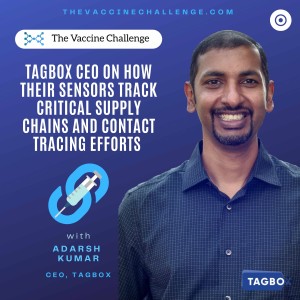
Thursday Apr 15, 2021
Thursday Apr 15, 2021
This episode of The Vaccine Challenge is hosted by Priyanka Asera and features Adarsh Kumar, CEO of TagBox.
TagBox helps support track & trace for critical supply chains through the use of IoT sensing. The sensors they use have been developed in-house and are merely the size of a matchbox. They claim it offers a better substitute to the age-old data logging system by enabling real-time tracking and other crucial metrics.
Due to the pandemic, they’ve seen surprising use cases for these little guys – such as contact tracing amongst individuals working in crowded or closed spaces. For this, and how they help aid vaccine distribution in the second largest populous country in the world – listen on!
Topics touched upon:
What is TagBox and what do you help solve?
- TagBox enables organizations to create smarter and more reliable supply chains. They do that with a unique product that combines IoT-based sensing, ML-based insights and AI-driven actions. They provide hardware, software and analytics.
- Three weeks ago TagBox was featured in Singapore’s 2021 budget speech by their Deputy PM for work related to COVID (more below)
- Key industries they help is life sciences, healthcare, F&B, high tech and discrete manufacturing. They help solve for temperature compliance, product damage, SKU or batch traceability and operational efficiency.
Can you talk more about India’s vaccination drives and efforts and what’s the role that tech startups like yours play to aid vaccine distribution?
- India has a robust vaccine program. The government has also created a tech backbone for vaccine distribution called “eVIN” - which stands for Electronic Vaccine Intelligence Network. This is the tech infrastructure for monitoring the vaccine temperatures in the cold storage depots and warehouses that the government uses. It also manages the flow of the vaccine and stock. During COVID, the government also launched CoWin - an app for inoculation and beneficiary management
- WHO reports that most temperature excursions happen in-transit and during handoffs. Having a complete view of the entire cold chain is where you get the complete picture and that’s where tech start-ups add value with real-time monitoring throughout the value chain.
- Typically - a manufacturer supplies the vaccines to the regional government medical store (GMSD). From there, it goes to a state store, and then to a district store, and eventually to a local hospital. Multiple handoffs happen. Usually, the time period could be 3-6 months for other vaccines. But in the case of COVID, the period is much shorter. In some cases, active cooling is used (eg. reefer trucks), in other cases passive cooling is used (eg. ice packs, gel packs etc). If temperature exposure happens, vaccines are susceptible to losing efficacy.
- Traditionally used Vaccine Vial Monitors (VVM) - the strips that change colour upon excursion - are manual and don't always get logged as intended especially for such large scale work
What does the pharma industry do currently for tracking vaccines? And how are TagBox’s sensors different?
- Pharma has been traditionally using “data loggers”. At each handoff, someone has to manually plug it into a computer USB, a PDF report would get generated which has all temperature & location history etc. This needs to be sent to their QA department who will confirm that everything is okay. TagBox is suggesting using sensors that give real time data throughout, and to all parties in the value chain
- These sensors provide not just temperature excursion data in real time, but location data, shock data, light data and other metrics that can also help solve issues such as counterfeiting etc.
- The leap is not conducting data integration from multiple sources, but instead making data acquisition itself so simple that everyone can partake in it and believe it
You helped the Singapore government with contact tracing when they reopened post the lockdown? What was that, and what other applications does this have?
- TagBox converted the sensors in an ID card format where it helped with contact tracing efforts. For eg. if two factory workers come closer than what’s acceptable, their sensors will start beeping. It also creates a contact trace history so that if there is a case of COVID in a factory, you don’t have to rely on the memory of the person to know who they came in contact with
- Applications for this can be in any closed spaces where contact tracing is beneficial. Eg. Warehouses or construction sites.
About Adarsh:
Adarsh is the Co-Founder and CEO of an exciting startup, TagBox. TagBox is helping organizations to make their supply chains more reliable by solving problems like quality & compliance, end to end traceability and operational efficiency. TagBox has a singular product that solves these problems using an integration of IoT based sensing, ML based predictive insights and AI based actions and recommendations. TagBox is now an industry recognized name with the likes of IMDA, Nasscomm, CII, TVS Motors, Qualcomm and SAP endorsing its solutions.
Adarsh is a global analytics leader, with over 15 years of experience in providing Advanced Analytics solutions in the areas of Supply Chain and Banking to Fortune 500 companies. Before starting TagBox, he was a part of the senior leadership team at Mu Sigma, managing a multi-million dollar portfolio for analytics service delivery. Adarsh is passionate about usage of Machine Learning and AI for solving real-life business problems.
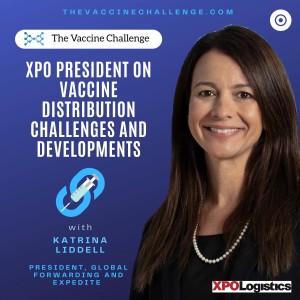
Wednesday Apr 07, 2021
XPO President on Vaccine Distribution Challenges and Developments
Wednesday Apr 07, 2021
Wednesday Apr 07, 2021
This episode of The Vaccine Challenge is hosted by Priyanka Asera and features Katrina Liddell, President Global Forwarding & Expedite, XPO Logistics. Prior to XPO, Katrina’s also been on the shipper side– working at Johnsons Controls for 14 years. XPO is one of those unique providers that assist in vaccine deployment throughout the supply chain – right from the first mile to the last mile and so they bring a very well rounded and end to end perspective.
There have been many heart-warming stories of their people that have been on the frontlines since the pandemic began, right up to today. The essential nature of their work, along with thousands of other frontline workers, has kept our way of life moving forward and we discuss some of their initiatives and challenges in making this possible.
Topics touched upon:
What is XPO’s reach and speciality:
- 100,000 employees across 30 countries. Partnered with more than 50000 customers across all major industries - including retail, industrial, pharma, manufacturing.
- Provides services in the first mile, middle mile and last mile including air cargo, full truckload and parcel deliveries
- Specifically for vaccine transportation, XPO has temperature validation devices and strict condition requirements for trailers.
- XPO Connect is their real time visibility technology that provides eyes on every truck, and can provide this visibility to all customers and to customer’s customer
What are your 3 biggest challenges within vaccine distribution:
- Vaccine supply fluctuations: The supply has improved but still evolving and its availability fluctuates
- Capacity: Other items associated with the vaccine. PPE, syringes, gloves, masks, gowns. XPO works closely with manufacturers providing all this other stuff that enable innoculations to happen.
- Temperature control: Managing excursions. XPO has very high standards for temperature control.
Touch on distribution operations, and variables that affect operations
- We move products from various facilities to both air freight hubs, distribution centers (DC) or cold storage. In some cases, even to the final point of use
- Once the vaccine arrives at a DC, it is deconsolidated and then parceled to the final point of use
- Final mile parcel delivery is the most difficult/tightest. Parcel delivery networks can really get clogged up.
What are some key security challenges and how do you solve for it:
- Local police escort with trucks in some cases
- Team drivers in temperature validated trucks so there is someone present at all times
- Nobody discusses details of what commodity is in a truck except the shipper and consignee. We don’t want anyone to know if a refrigerated truck has produce or 200,000 dozes of the COVID vaccine
- Industry standard: Not stopping within a 250 mile radius of the shipper once loaded
What other ways are you supporting overall COVID relief
- Moving saline, PPE, syringes, sprayers, styrofoam, dry ice, temp controlled packaging, plastic & labels, sedatives, inhalers, OTC anti-cold and cough medicine. We want to make sure clinics are stocked with all items needed for relief efforts and requirements have changed drastically from when the pandemic hit in March 2020 to now.
- We don’t manufacture dry ice, but we can transport it. It’s used as a passive cooling device. It reduces the difference in temperature between what’s inside the package and outside
What interesting partnerships have you formed?
- NYC emergency management department has partnered with XPO. We help them 24/7 logistics support for emergency distribution of supplies. Eg. MRE’s, OTC medical product, rubber gloves, sanitizers, blankets, baby formula
What’s going to change long term as a result of this pandemic?
- Pace of online shopping will massively continue growing. eCommerce volume today is what was predicted for 2025. It’s accelerated massively
- Changes in order preparation, inventory management, omnichannel strategy - both B2C and B2B, pure-play eCom players will need more help in warehousing and distribution, contactless delivery will continue to remain an option
- Shipper board rooms will be discussing: Do we have a business model to support ecom, and if not, should we? How do we get to a customer faster? How do we forward stock and manage our inventory?
About Katrina
Katrina Liddell has responsibility for XPO's global forwarding and expedite operations in North America. Previously, she served as head of sales for XPO’s North American transportation group. Ms. Liddell joined the company following 14 years with Johnson Controls International, where her positions included general manager of the global building automation systems business, and senior roles in enterprise account management, vertical market development, operations and customer relations. She holds a juris master degree from Emory University School of Law and a bachelor’s degree in chemical engineering from Georgia Institute of Technology.

